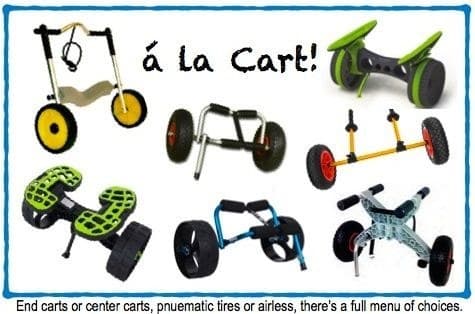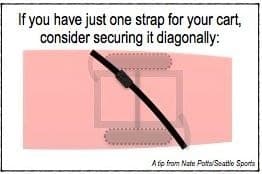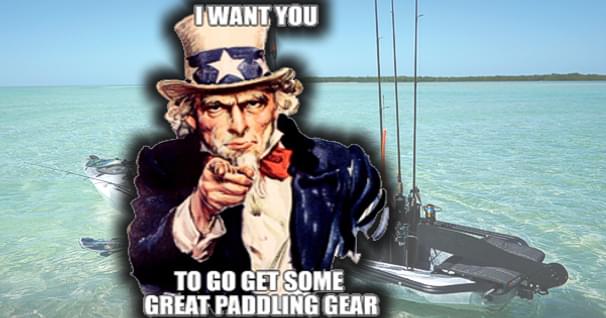Boat Carts
Whether you've ever had to portage a kayak any distance or merely move it up the beach from water's edge while loaded, you can appreciate the convenience of a cart to help transport your kayak. Canoers dealing with long portages or extended river access points might also find a cart to be a useful advantage. In either case, the option of using a cradle on wheels to haul your boat makes for worthy consideration.
Carts are hardly the rocket science gear of paddling. Basically a cart needs to have the following attributes to be effective:
- a rugged frame capable of handling the anticipated loads it will bear
- wheels tall/wide enough to handle the load across various surface conditions
- a carriage/craddle adequate for the size of the boat; to securely nestle it onto the frame
- cushioning to protect the boat from damage
- straps or other methods for holding the boat firm on cart, prevent/minimize load shifting
- ability to breakdown, collapse for stowage on/below deck of craft
In some parts of the country, access to put-in launch sites are limited to non-motorized vehicles so even though shouldering your kayak or portaging your canoe is an option, carrying all your gear and your boat on a cart may save you a trip as well as stress or fatigue on certain parts of your anatomy. Such scenarios may also mean going from pavement or hard-pack to soft, wet shoreline environments all in the same transport.


Let's look in a little more detail, each of the components to consider when deciding upon which cart to consider:
WHEELS/TIRES
The most critical element in a cart's make-up are its wheels. If they are too narrow they may sink into the sand, if they are too soft and wide, they may be sluggish on harder ground. Sometimes wheels tend to plow the sand in front of them rather than riding over it. Generally a wider, softer tire is going to travel over soft terrain with more ease, and less impact/resistance than a narrow wheel. Picture the wheels on vehicles riding over the delicate tundra.
Wheels/tires can be pneumatic (filled with air) or solid/foam cored (airless). Air-filled tires (included the "balloon" type) can be adjusted for hardness depending upon the terrain, but can also leak and/or be hard to re-inflate in the field. An airless tire is what-you-have-is-what-you-get, no adjustments. However, depending upon the width, it's always ready to perform.
Both types should be firmly secured/locked onto the axel/frame, yet easily removed for stowage as the cart folds down or is disassembled. Carts with wider wheel bases tend to work better on softer terrain; narrower bases for harder surfaces. The type of wheel and the material used to make the wheel will affect both the weight and cost of the cart. Axel height is also a consideration depending upon the terrain. And, of course, plastic wheels don't rust, and some do have a rubber tread applied to the wheel's contact surface.
FRAMES
Almost all frames are made from sturdy, but lightweight, anondized aluminum. A few cart makers also offer frames of molded polypropylene. Typically frames are classified as:
1. center-cart carry (cart positioned somewhere near the midpoint of the boat)
2. end-cart carry (cart attached near bow/stern and leveraged at the opposite end when transporting)
3. plug-in (typically incorporating scupper holes on SUPs)
Carts either collapse/fold down quickly into individual or sectional pieces for stowing, or disassemble quickly and easily (take care not to lose any separate pieces such as cotter pins for the wheels).
KICKSTAND
Some carts add a kickstand to help stabilize the cart during loading. Kickstand can be spring-loaded or otherwise hinged to swing up and out of the way during transit.

TIE DOWNS
Straps are pretty much standard issue on all carts. Make sure the buckle or clips are padded to prevent scratching the boat. In addition, paddling/pads are usually applied along the cradle portion of the frame to help seat the boat on the frame and to prevent scratches as well.

Straps should be wrapped around a secure cross strut on the frame and should not be able to slip or slide in transit. Typically two straps are tightened parallel across the deck of the kayak. If you have just one strap, consider crossing the strap from front strut on one side of the cart to the rear strut on the opposite side for a grip that is less likely to cause the boat to shift.
Some end carts don't require strapping to secure the kayak to the cart, but rather rely on it's weight and position to hold it firmly on the frame.
TIPS ON CARTING YOUR KAYAK OR CANOE
- To keep better control of your loaded boat, have more than half of the load on the towing end
- Double check your straps when traveling across sloped terrain
- As with any marine gear, do a thorough rinse after use, especially in salt water environments
The choices of carts are many, and the decisions based mostly on the type of boat (weight, width, etc.) and the types of terrain over which you'll be carting your canoe or kayak. Consider, too, the load limits it can bear; many are less than 100 pounds while top load weights can be upwards of 200 pounds. Other factors include the actual weight of the cart and how easy it can be broken down and stowed.
Clearly a cart increases our opportunity to get out on the water, so be safe and have fun out there!
Tom Watson is an avid sea kayaker and freelance writer. For more of Tom's paddling tips and gear reviews go to his website: www.wavetameradventures.com He has written 2 books, "Kids Gone Paddlin" and "How to Think Like A Survivor" that are available on Amazon.com.
Related Articles
Spring is here and (hopefully) you've got your tax returns completed by now. If you find yourself with a…
One of the great things I love about the sport of kayaking (and fishing from kayaks) is getting someone…
Recently a buddy of mine needed an extra kayak for one of his out of town guests to use for the…
The more I look around, the more kayaks I see out on the water. I have often wondered when the market…


